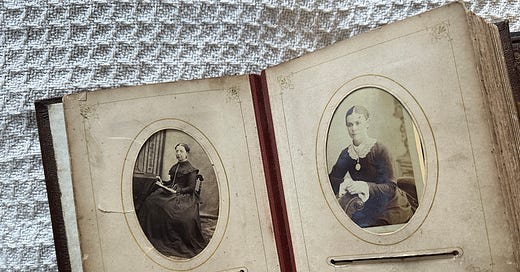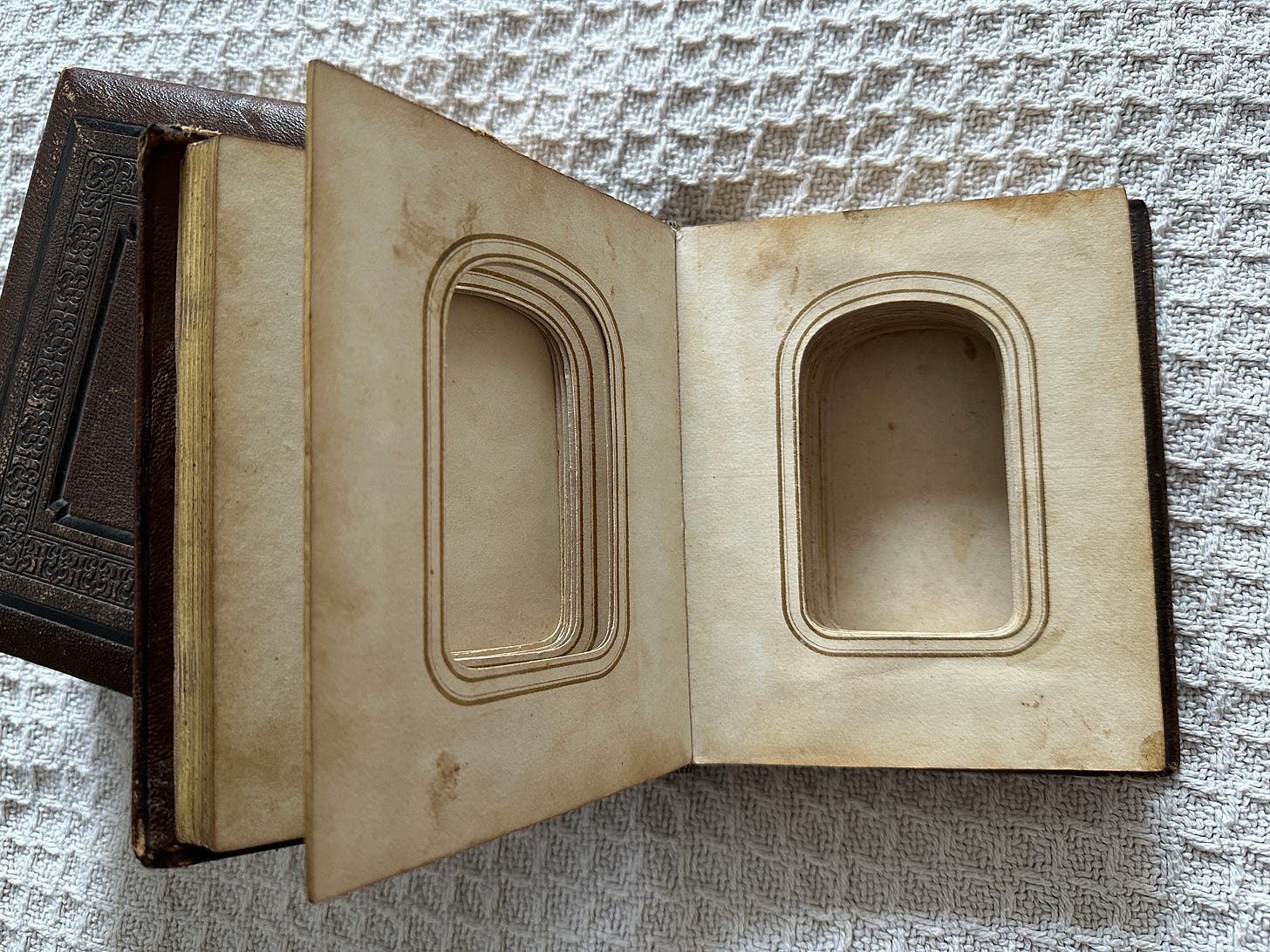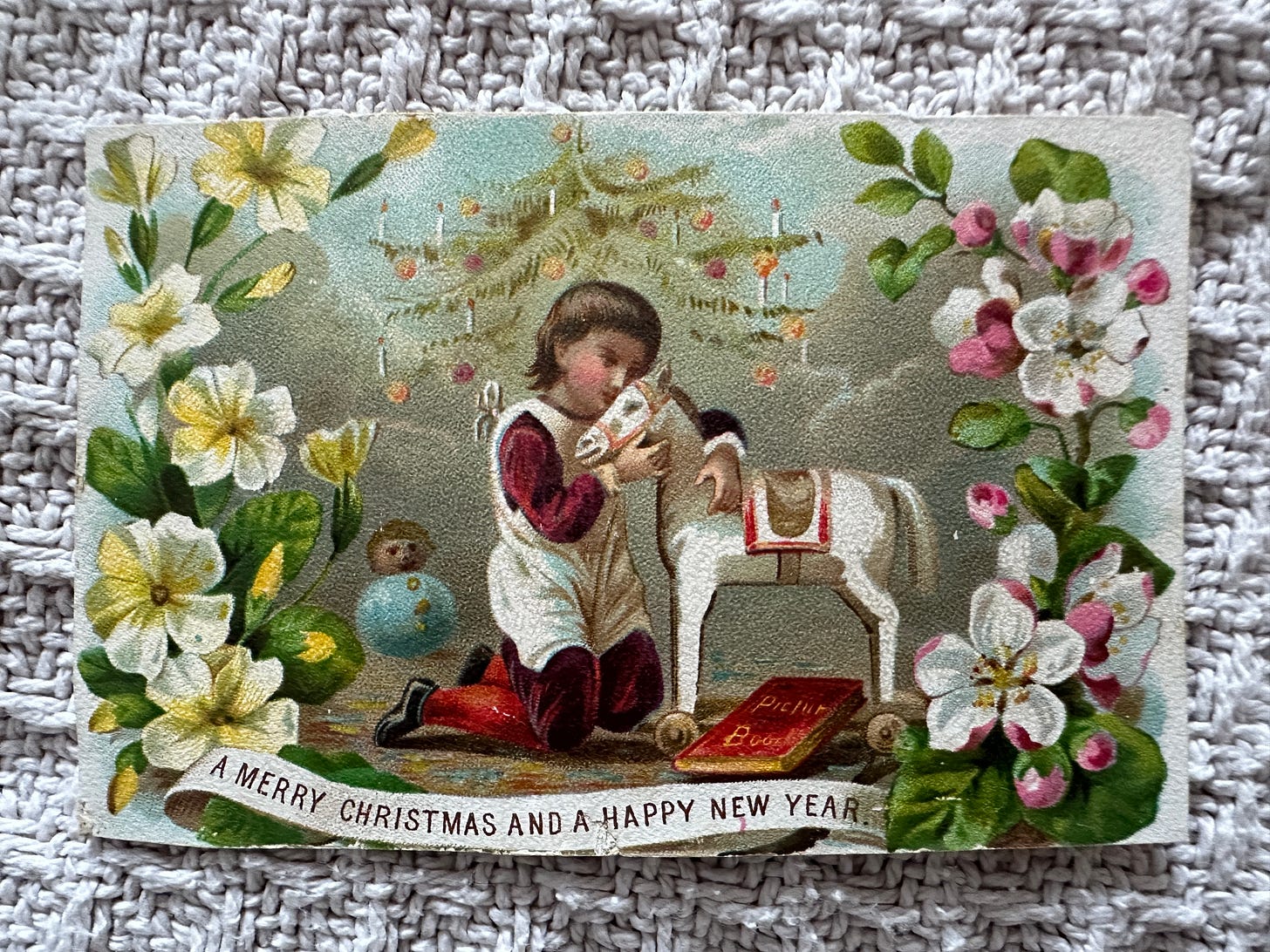The Ghost Keeper
On a new, potentially dangerous habit; collecting antique photographs
Hello friends,
I am here to warn you about a dangerous and highly addictive habit which has recently come to my attention. It’s called ‘collecting historical photographs’ and their popular method of distribution: the online auction. Friends, beware!
A fortnight ago, for the first time ever, I found myself bidding for a box of Victorian CDV photographs, the Instagram of that era. Cartes de visite (CDV) photograph cards were a nineteenth century sensation, capturing the essence of Victorian charm and innovation. These pocket-sized cards, measuring approximately 6.5 by 10 cms (2.5 by 4 ins), were calling cards combining the intimacy of a personal token with the elegance of a miniature portrait.
CDVs were not just personal keepsakes; they were social currency. Exchanged among friends and family, displayed in parlours, and collected in albums, these cards were a testament to a burgeoning fascination with photography. The back of each card often featured the photographer's studio information, adding a touch of historical and geographical context. Today we’d call this metadata. [Here’s a great little PDF on the phenomenon]
An hour after placing my bid, I was still the highest bidder! At 2 pm, when the auction was ‘closed’, a notification appeared that I had won the lot. The auction house has a rule that winners must collect their lots within 24 hours. So I dutifully collected an unassuming A4 box crammed with sepia-ed photos. This was better than Christmas.
A week later, I was back at the warehouse queuing for my next successful lot; a pair of leather albums, one of them practically full of CDVs, the second one almost empty. This was fast becoming a habit. As a result, I’ve had to stop myself looking at the upcoming auction notifications because there’s only so many Victorian Carte De Visite photos you can own, right?
I will talk about the box of photos in a future post. First, the albums.
At first, I was underwhelmed when the rustic, chunky albums were put into my hands at the warehouse. True to their description, the larger of the two albums was quite full of images. The smaller album was empty except for a single photo of a whiskered, middle-aged man. All the images were of Australians and photographed in Sydney or Melbourne. There were a few tin-type images and a collection of men, women and a few children.
First, I cleaned the album covers. Then I wiped the pages with a dry microfibre cloth. I removed the photographs by sliding them through the provided slits at the bottom of each page. I wiped all the cards as best as I could, not really knowing what else to do.
Who are these faces staring out at me? At first I felt such sadness knowing there were so many images looking for their stories. But the more I read about the Victorian photography industry, the more I understood that millions of these cards were produced. The card owners may be unknown to me, but it’s possible someone else may have the same card with a life story intact and a mystery to solve.
The next time I opened the album of images, I noticed the ephemera: portions of Christmas cards and other small cards containing biblical phrases. I felt as if this album may have belonged to a woman.
The Christmas card cutout had a logo on the back. “De La Rue No. 94”. The De La Rue printing company apparently only made greetings cards between the years of 1875-1885. My excitement levels shot up. My album was around 140 years old!
I still know nothing about the people in the photos. I call them my ghosts. But me and my ghosts are on a journey together. I will keep searching for their names and stories. My ‘habit’ cost under US$100 and has already brought me many hours of delight.
Friends, I’d love to know what you collect. Did you inherit it/them or buy them? What is it that brings you joy? Maybe you can help me discover more about these images?
Now if you excuse me, I’m just going to check next week’s listing. Just to take a peek. Not to bid. I promise.
[Acknowledgements: the description of CDVs was created with the aid of a ChatGPT prompt. I asked a question and edited the answer. The rest of the words are mine. Thanks to my brother Stephen Hutcheon for sending the auction notifications my way. We both love family stories]









I collect blue plates. 38 years ago I visited an antique shop in Berry NSW and saw these Willow pattern plates. There were two at $30 each, way beyond my budget. I headed home via Kangaroo Valley, stopped at a garage sale, picked up the same plates for only 10 cents each. I’ve been collecting ever since. Slowed down a bit over the last decade realising, no one in my family will want them when I’m gone, they’ll just end up at an op shop. I also have two books awarded to my great grandmother in 1901 when she was in third class. This started my obsession with reading and books, although I have none of any value.
Hi Jane, there’s a really informative webpage on the National Archives of Australia that specifically addresses photography & the preservation of photographs. It’s also got a link to the Australian Standards for the Physical Conditions for Preservation & Storage & very useful information on what adaption’s & accommodations can be made if you don’t possess facilities that meet the standards. (who does?). If I recall correctly, there is also some information available in the Film Archives. It’s a great hobby. I suspect you’ve entered your rabbit hole dear Alice! Cheers, Melba